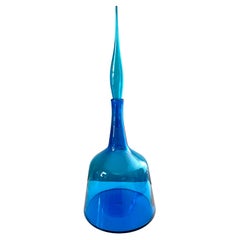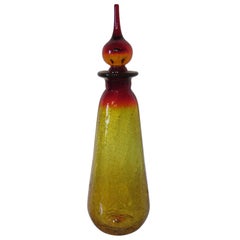Blenko Joel Meyers
Mid-20th Century American Mid-Century Modern Vases
Glass, Blown Glass, Art Glass
People Also Browsed
2010s Italian Mid-Century Modern Vases
Art Glass, Blown Glass
20th Century American Mid-Century Modern Glass
Glass, Blown Glass
Vintage 1960s American Mid-Century Modern Glass
Vintage 1960s Swedish Scandinavian Modern Glass
Glass, Art Glass, Blown Glass
Vintage 1950s Danish Mid-Century Modern Vases
Blown Glass
Mid-20th Century Finnish Mid-Century Modern Vases
Blown Glass
2010s Italian Modern Vases
Glass
Mid-20th Century French Mid-Century Modern Vases
Blown Glass
Antique 15th Century and Earlier Italian Classical Roman Glass
Glass
2010s Italian Modern Vases
Glass
Vintage 1980s Italian Mid-Century Modern Glass
Art Glass, Blown Glass, Cut Glass
2010s American Post-Modern Vases
Resin, Plaster
Vintage 1940s Italian Modern Garniture
Crystal
2010s Swedish Organic Modern Vases
Art Glass, Blown Glass, Glass
Recent Sales
Mid-20th Century American Mid-Century Modern Vases
Blown Glass
Mid-20th Century American Mid-Century Modern Glass
Glass
Blenko Glass for sale on 1stDibs
A producer of hand-blown glass since 1893, Blenko Glass is currently headquartered in Milton, West Virginia, where it has operated since 1921. Among its many illustrious projects are the stained-glass windows it produced for St. Patrick’s Cathedral and the Washington National Cathedral. Blenko is known today for the brilliant colors of its glass vessels and objects—particularly those produced in the 1950s and ’60s—which range from jewel-like blues and greens to brilliant reds and yellows.
The company was founded by William J. Blenko, an English immigrant who was apprenticed to a glassmaker in his native London as a young man. Blenko developed expertise in the production of rondels, the round panes used in stained glass windows. His interest in the potential of natural gas to fire glass furnaces led him to Milton, where abundant reserves of the fuel had attracted a pool of skilled glassblowers. Under the name Eureka Glass, his company began making window glass in 1923, and in 1925, he was joined in the business by his son, William H. Blenko.
When the Great Depression quelled demand for stained glass, William J. Blenko brought local Milton glassblowers into the company to begin producing stem- and tableware, products for which the company, which changed its name to Blenko in 1930, is now best known. Up until the end of World War II, Blenko’s tableware designs were fairly straightforward, and they sold well at American department such as Gump’s, in San Francisco. The company was also commissioned in 1930 to produce a line of reproductions for Colonial Williamsburg.
In 1947, the company hired as its art director Winslow Anderson, who introduced artful, fanciful and modern vessels and objects in vibrant colors. This began what collectors refer to as Blenko’s “historic period.” A number of Anderson’s designs were honored by the Museum of Modern Art’s Good Design Awards in 1950, and throughout the 1950’s and ‘60s, the company enjoyed robust sales and critical acclaim. The forms Blenko produced during this period followed the contemporary vogue for biomorphism, or organic modernism, which favored rounded and fluid shapes inspired by nature.
One of Blenko’s most influential designers, Wayne Husted, who was active from 1953 to ’63, is credited with aligning Blenko’s products with the prevailing mid-century modern aesthetic by pushing the envelope on both form and color, particularly in his wedge-cut and Spool decanters and his Echoes series. Joel Philip Myers, who designed for Blenko in the 1960s, brought a sense of whimsy and visual excess to the product line, in keeping with the psychedelic look favored during the period.
Blenko Glass still produces many of its classic designs in items ranging from stemware and tableware to decorative objects and ornamental decanters. Among collectors, pieces created under Husted’s creative direction are of special interest. The company has come to the attention of younger audiences through the documentaries Blenko: Hearts of Glass and Blenko Retro: Three Designers of American Glass, both of which aired on PBS. Blenko also designed the glass award trophy for the Country Music Awards.
A Close Look at Mid-Century Modern Furniture
Organically shaped, clean-lined and elegantly simple are three terms that well describe vintage mid-century modern furniture. The style, which emerged primarily in the years following World War II, is characterized by pieces that were conceived and made in an energetic, optimistic spirit by creators who believed that good design was an essential part of good living.
ORIGINS OF MID-CENTURY MODERN FURNITURE DESIGN
- Emerged during the mid-20th century
- Informed by European modernism, Bauhaus, International style, Scandinavian modernism and Frank Lloyd Wright’s architecture
- A heyday of innovation in postwar America
- Experimentation with new ideas, new materials and new forms flourished in Scandinavia, Italy, the former Czechoslovakia and elsewhere in Europe
CHARACTERISTICS OF MID-CENTURY MODERN FURNITURE DESIGN
- Simplicity, organic forms, clean lines
- A blend of neutral and bold Pop art colors
- Use of natural and man-made materials — alluring woods such as teak, rosewood and oak; steel, fiberglass and molded plywood
- Light-filled spaces with colorful upholstery
- Glass walls and an emphasis on the outdoors
- Promotion of functionality
MID-CENTURY MODERN FURNITURE DESIGNERS TO KNOW
- Charles and Ray Eames
- Eero Saarinen
- Milo Baughman
- Florence Knoll
- Harry Bertoia
- Isamu Noguchi
- George Nelson
- Danish modernists Hans Wegner and Arne Jacobsen, whose emphasis on natural materials and craftsmanship influenced American designers and vice versa
ICONIC MID-CENTURY MODERN FURNITURE DESIGNS
- Eames lounge chair
- Nelson daybed
- Florence Knoll sofa
- Egg chair
- Womb chair
- Noguchi coffee table
- Barcelona chair
VINTAGE MID-CENTURY MODERN FURNITURE ON 1STDIBS
The mid-century modern era saw leagues of postwar American architects and designers animated by new ideas and new technology. The lean, functionalist International-style architecture of Le Corbusier and Bauhaus eminences Ludwig Mies van der Rohe and Walter Gropius had been promoted in the United States during the 1930s by Philip Johnson and others. New building techniques, such as “post-and-beam” construction, allowed the International-style schemes to be realized on a small scale in open-plan houses with long walls of glass.
Materials developed for wartime use became available for domestic goods and were incorporated into mid-century modern furniture designs. Charles and Ray Eames and Eero Saarinen, who had experimented extensively with molded plywood, eagerly embraced fiberglass for pieces such as the La Chaise and the Womb chair, respectively.
Architect, writer and designer George Nelson created with his team shades for the Bubble lamp using a new translucent polymer skin and, as design director at Herman Miller, recruited the Eameses, Alexander Girard and others for projects at the legendary Michigan furniture manufacturer.
Harry Bertoia and Isamu Noguchi devised chairs and tables built of wire mesh and wire struts. Materials were repurposed too: The Danish-born designer Jens Risom created a line of chairs using surplus parachute straps for webbed seats and backrests.
The Risom lounge chair was among the first pieces of furniture commissioned and produced by legendary manufacturer Knoll, a chief influencer in the rise of modern design in the United States, thanks to the work of Florence Knoll, the pioneering architect and designer who made the firm a leader in its field. The seating that Knoll created for office spaces — as well as pieces designed by Florence initially for commercial clients — soon became desirable for the home.
As the demand for casual, uncluttered furnishings grew, more mid-century furniture designers caught the spirit.
Classically oriented creators such as Edward Wormley, house designer for Dunbar Inc., offered such pieces as the sinuous Listen to Me chaise; the British expatriate T.H. Robsjohn-Gibbings switched gears, creating items such as the tiered, biomorphic Mesa table. There were Young Turks such as Paul McCobb, who designed holistic groups of sleek, blond wood furniture, and Milo Baughman, who espoused a West Coast aesthetic in minimalist teak dining tables and lushly upholstered chairs and sofas with angular steel frames.
As the collection of vintage mid-century modern chairs, dressers, coffee tables and other furniture for the living room, dining room, bedroom and elsewhere on 1stDibs demonstrates, this period saw one of the most delightful and dramatic flowerings of creativity in design history.
Finding the Right vases for You
Whether it’s a Chinese Han dynasty glazed ceramic wine vessel, a work of Murano glass or a hand-painted Scandinavian modern stoneware piece, a fine vase brings a piece of history into your space as much as it adds a sophisticated dynamic.
Like sculptures or paintings, antique and vintage vases are considered works of fine art. Once offered as tributes to ancient rulers, vases continue to be gifted to heads of state today. Over time, decorative porcelain vases have become family heirlooms to be displayed prominently in our homes — loved pieces treasured from generation to generation.
The functional value of vases is well known. They were traditionally utilized as vessels for carrying dry goods or liquids, so some have handles and feature an opening at the top (where they flare back out). While artists have explored wildly sculptural alternatives over time, the most conventional vase shape is characterized by a bulbous base and a body with shoulders where the form curves inward.
Owing to their intrinsic functionality, vases are quite possibly versatile in ways few other art forms can match. They’re typically taller than they are wide. Some have a neck that offers height and is ideal for the stems of cut flowers. To pair with your mid-century modern decor, the right vase will be an elegant receptacle for leafy snake plants on your teak dining table, or, in the case of welcoming guests on your doorstep, a large ceramic floor vase for long tree branches or sticks — perhaps one crafted in the Art Nouveau style — works wonders.
Interior designers include vases of every type, size and style in their projects — be the canvas indoors or outdoors — often introducing a splash of color and a range of textures to an entryway or merely calling attention to nature’s asymmetries by bringing more organically shaped decorative objects into a home.
On 1stDibs, you can browse our collection of vases by material, including ceramic, glass, porcelain and more. Sizes range from tiny bud vases to massive statement pieces and every size in between.



